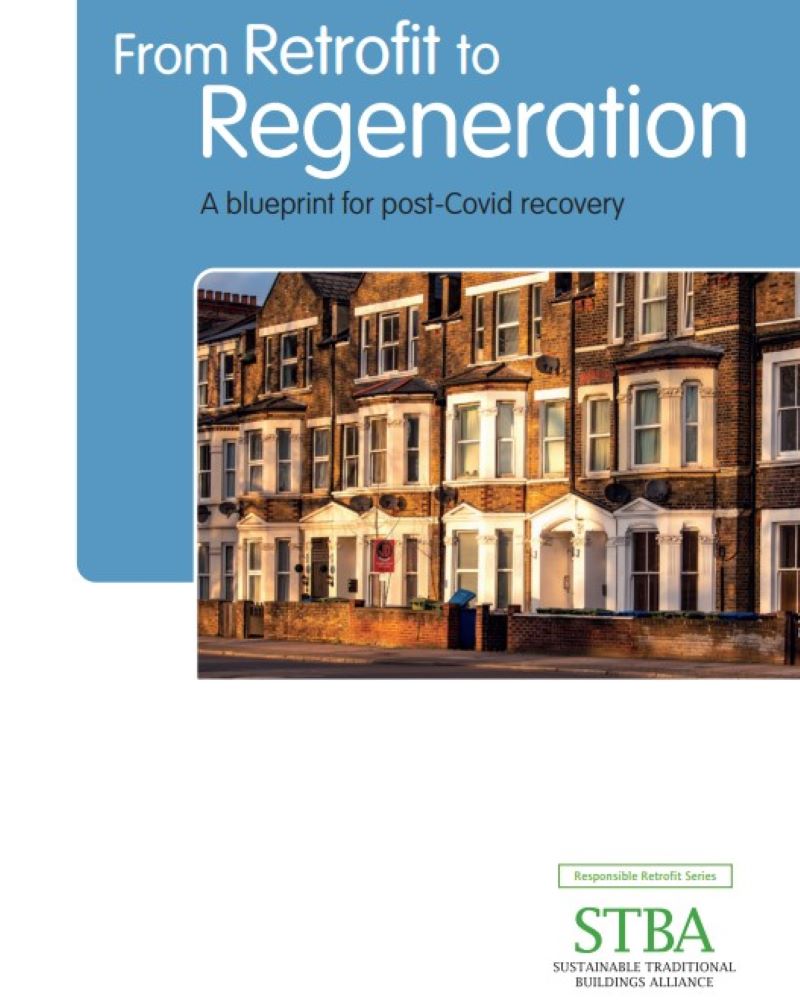STBA report to provide blueprint for post-COVID recovery

|
A report from the Sustainable Traditional Building Alliance (STBA) says a well-thought-out programme of regeneration would enable the Government to present a post-COVID recovery which delivers all the objectives of health, heritage, community cohesion, local employment, cleaning and re-greening the environment, transport, and flood alleviation. The report is available from the STBA website.
Entitled 'From Retrofit to Regeneration: A blueprint for a post-COVID recovery', the report says, "Regeneration has to be planned and delivered (principally) at a community level, as many of these benefits can only be realised through co-operation and joined-up thinking, which should in turn inform the funding mechanisms."
The findings show that, "During the pandemic there has been a genuine appetite among many people to see a fundamental change in how we live, how we share resources and space. There has also been a sudden and huge interest in welfare economics (as opposed to GDP)."
The report's author Nigel Griffiths, says, "This paper explains why and how we got it wrong in the past, sets out the broader regeneration approach and provides a template to embed genuine sustainability into our forward planning for the built environment."
The STBA says it is calling on central government to establish a Department for Sustainability (transferring Energy, Housing and Communities to this new body) and a resetting of societal priorities away from consumerism and economic aims and towards wellbeing. It is urging local authorities to:
- Form an agenda that is considered in future planning.
- Re-assess existing development planning to minimise or eliminate green field development.
- Convert redundant commercial sites to residential use, community use.
STBA also recommends social, private housing landlords and housing developers to look again at their regeneration agenda and shift operations accordingly.
CIAT is a supporting organisation of STBA, and Professor Sam Allwinkle PPBIAT FCIAT is STBA Industry Chair.
This article originally appeared on the CIAT website. It was published on 20 December 2021.
--CIAT
[edit] Related articles on Designing Buildings
- Areas for regeneration.
- CIAT articles.
- Coronavirus and the construction industry.
- Government departments responsibility for construction.
- Local planning authority.
- Planning4People.
- Regeneration.
[edit] External resources
Featured articles and news
One of the most impressive Victorian architects. Book review.
RTPI leader to become new CIOB Chief Executive Officer
Dr Victoria Hills MRTPI, FICE to take over after Caroline Gumble’s departure.
Social and affordable housing, a long term plan for delivery
The “Delivering a Decade of Renewal for Social and Affordable Housing” strategy sets out future path.
A change to adoptive architecture
Effects of global weather warming on architectural detailing, material choice and human interaction.
The proposed publicly owned and backed subsidiary of Homes England, to facilitate new homes.
How big is the problem and what can we do to mitigate the effects?
Overheating guidance and tools for building designers
A number of cool guides to help with the heat.
The UK's Modern Industrial Strategy: A 10 year plan
Previous consultation criticism, current key elements and general support with some persisting reservations.
Building Safety Regulator reforms
New roles, new staff and a new fast track service pave the way for a single construction regulator.
Architectural Technologist CPDs and Communications
CIAT CPD… and how you can do it!
Cooling centres and cool spaces
Managing extreme heat in cities by directing the public to places for heat stress relief and water sources.
Winter gardens: A brief history and warm variations
Extending the season with glass in different forms and terms.
Restoring Great Yarmouth's Winter Gardens
Transforming one of the least sustainable constructions imaginable.
Construction Skills Mission Board launch sector drive
Newly formed government and industry collaboration set strategy for recruiting an additional 100,000 construction workers a year.
New Architects Code comes into effect in September 2025
ARB Architects Code of Conduct and Practice available with ongoing consultation regarding guidance.
Welsh Skills Body (Medr) launches ambitious plan
The new skills body brings together funding and regulation of tertiary education and research for the devolved nation.
Paul Gandy FCIOB announced as next CIOB President
Former Tilbury Douglas CEO takes helm.























